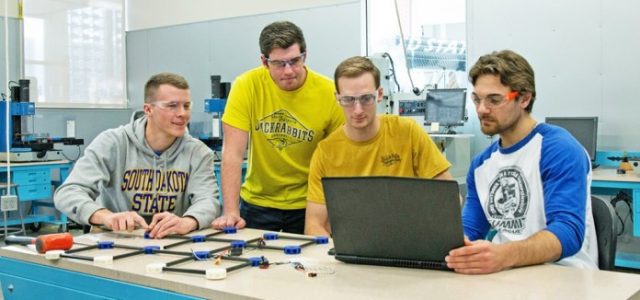Engineering students at South Dakota State University are designing a drone large enough to carry a human for their capstone senior design project, with help from a nearly $80,000 grant from NASA.
“NASA wants to address specific topics, one of which is related to innovation in aeronautic transportation,” explained assistant mechanical engineering professor Marco Ciarcià, the senior design group’s project adviser. “The air transportation initiative aims to gather innovative ideas and to inspire young engineers. Our team is proposing an autonomous aerotaxi; another team might propose something completely different, like to develop a software for air traffic management, for example.”
The team will receive half of the funding, but then must raise at least $2,000 through crowdsourcing to receive the remainder of the grant monies. Those wishing to donate to the ATLAS project can do so at https://spsr.me/YzJv until Jan. 17, 2020. The acronym stands for Advanced Transportation through Leading-edge Aerial Systems.
“It’s a very big project,” said Isaac Smithee, a senior in mechanical engineering from Hutchinson, Minnesota. Initially, the seven-member team will design and build a small-scale drone they have named the Hummingbird using off-the-shelf components.
“First, we need to validate our preliminary design,” Smithee said. The team will then use that proof of concept to build a large-scale drone called the Albatross, capable of lifting 200 to 250 pounds. The drones are battery-powered.
During the first experiments, the students will operate the drone via remote control, but it will eventually be autonomous, Ciarcià said. “The passenger will set the destination, push go and it will fly by itself.”
Assistant professor Todd Letcher, who teaches the senior design class and also oversees the drone team, said, “This is such an incredible opportunity for these students. Never before have we had an $80,000 senior design project. This is a chance to work on something a lot of people care about and that NASA cares about and is willing to support at a high level.”
Mechanical engineering major Wade Olson of Omaha, Nebraska, has been flying remote control airplanes for two years. “This project stood out to me because I love aeronautics and flying stuff,” Olson said. “We are in safe hands with Wade (on the team),” Smithee added.
Other team members are mechanical engineering majors Ryan Twedt of Hendricks, Minnesota, and Nick Runge of Sioux Falls; Matthew Berg, a business economics and entrepreneurial studies major from Baldwin, Wisconsin; Anthony Bachmeier, a communication studies, entrepreneurial studies and agricultural business major from Aberdeen; and electrical engineering master’s student Sterling Berg of DeSmet.
Because the deadline for completing the NASA project is Nov. 2, 2020, the timeline worked well for the two-semester senior design course series, which concludes in next spring, Ciarcià explained. The team was notified the Wednesday before Thanksgiving about receiving the grant.
“We are still kind of in shock,” Smithee admitted. “Now we have to make it fly,” Ciarcià added.



















